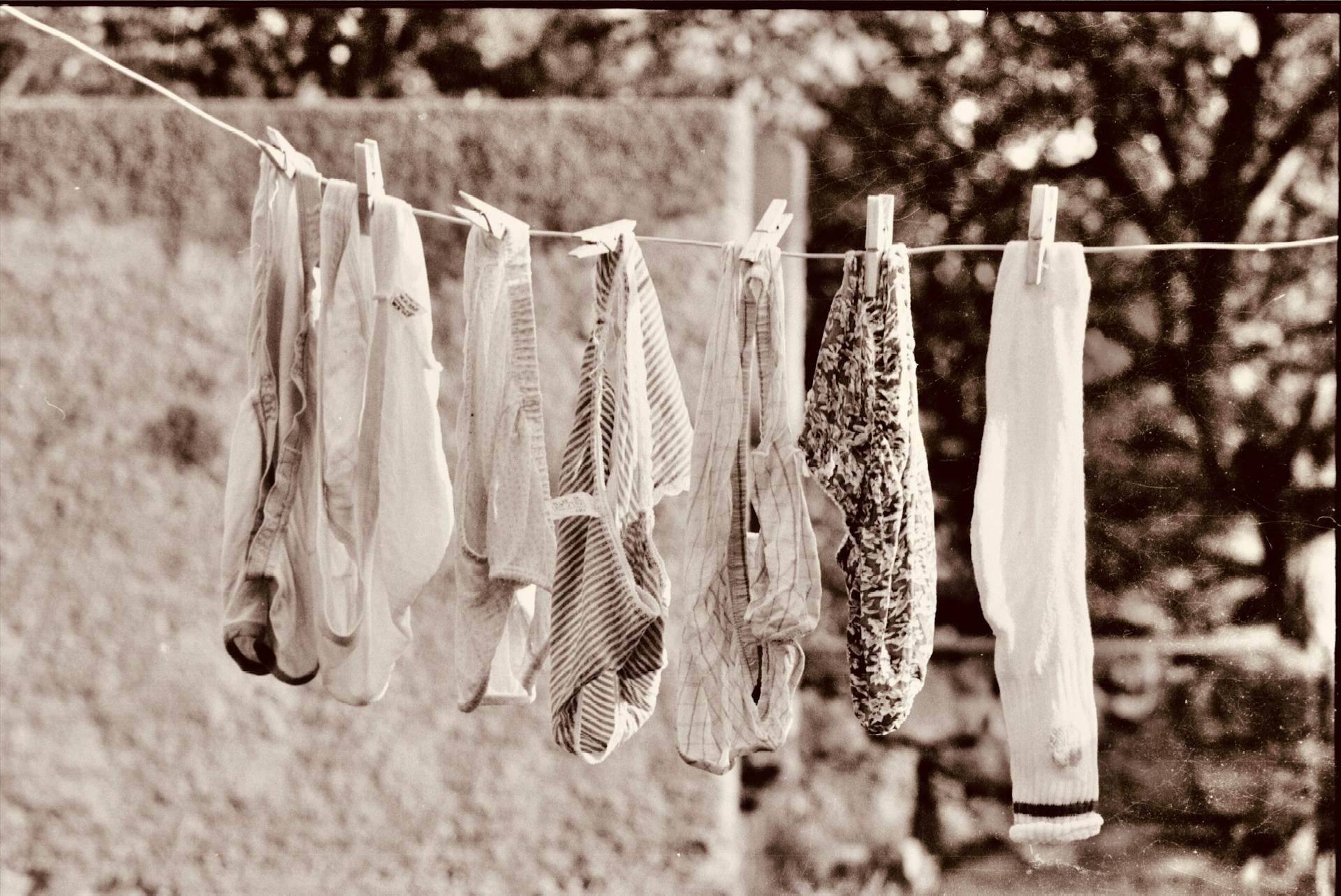
One of the more common stains people encounter and struggle to remove is betadine. Betadine, otherwise known as povidone iodine, is an antiseptic that’s used mostly by medical professionals and can be tricky to remove from clothing. However, betadine stain removal doesn't have to be a taxing process if you follow the right steps.
First, you’ll want to act fast when the accident happens and tackle the stain as soon as you can. Start by running cold water in reverse through the clothing for about 10 minutes if possible. This may be enough to lift the betadine from deep within the fabric fibers so you don’t need to move ahead with any other steps. If that doesn’t work though, you’ll want to pre treat your clothing before putting them in your washing machine. The solution is simple: create a damp paste using salt and cold water plus apply it directly onto the stain using your hands or a toothbrush.
Let it sit for at least 10 minutes before washing on cool setting use mild laundry detergent; avoid hot setting as high temperatures will make it more difficult to get the stain out! This could also make the yellow pigment in betadine permanently stick too so take caution when choosing temperatures. Following this process should remove most of what’s left on your clothes that weren’t lifted off with cold water alone or when mixed with salt solution earlier. As a final preventive measure against the stubbornness of certain stains like this one, consider using a strong solution of chlorine bleach mixed nicely with warm water for best results in getting rid of betadine stains on clothing.
All in all, getting rid of betadine stained clothing doesn't sound like an enjoyable experience but with consistent practice and determination you can make it happen with these easy-to-follow steps! Hopefully they enable you have successful end results that leave you satisfied knowing no trace was left behind from nasty old marks caused by accidents involving antiseptics like this one!
Expand your knowledge: Native Deodorant Stain Clothes
How to clean Betadine off clothes?
Betadine is one of the most popular antiseptics used for minor cuts and skin discoloration, but if you accidentally get it on your clothes, it's not something easily remedied. However, with a few careful steps, you can clean Betadine off your clothes and save them from irreparable damage.
Fortunately, Betadine is water-soluble at low concentrations. The first step to cleaning Betadine off of your clothing is to fill a sink or bucket with cold water and submerge the affected area of the garment in the water for up to an hour. Ensure that your hands are also covered with gloves when washing off the Betadine stain as it can be highly irritating to skin. If it contains bleach or any detergents, use rubber gloves for safety purposes. Once the stained area is submerged in cold water for an hour, take out the garment and check if there's still any traces of Betadine visible on the fabric. If so, repeat this step until all the stains have been removed.
Following this process, you can now move on to rinsing off the garment in lukewarm water and washing it gently by hand or in a washing machine using cold water. If you're using a machine-washable detergent, add some oxygen bleach before putting it into the machine. Oxygen bleach will help to break down stubborn protein stains like blood spills or animal organisms that may be present on your clothing alongside Betadine stain; regular chlorine bleaches must be avoided as these could damage your fabric's color pigmentations over time. Finally, hang-dry your clothe item thoroughly before attempting to wear them again for best results!
Consider reading: Formula Stains
What is the best way to get Betadine out of clothes?
Removing Betadine stains from clothes can be a daunting chore. The good news is that, if done properly, it can be done. Here are the steps to getting Betadine out of clothes:
1. Soak the stained garment in hot water for 10 to 15 minutes to loosen the stain - always make sure that the material won't shrink from hot water!
2. Apply a mixture of dishwashing liquid and white vinegar to the stained area and scrub gently with a cloth. Allow this to sit for about 15 minutes before running under cold water or rinsing it off with a hose.
3. If the stain still remains, you can try creating a paste with baking soda and water, which you can then spread on top of garment stain and let it sit overnight before washing again as normal.
4. If all else fails, it may be necessary to take your garment to a dry cleaner who can pre-treat the stain with specialized products that are not available over-the-counter in order to ensure the best possible result when cleaning yourBetadine stained clothes. Bonus tip: Always test an inconspicuous spot on your garment first in case of any unexpected reactions!
By following these steps you should be able to successfully get Betadine out of clothes without too much difficulty - happy laundering!
You might enjoy: How to Get Betadine Out of Clothes?
How do I remove dried Betadine from clothing?
Trying to remove that stubborn dried Betadine from clothing can be a daunting task - it doesn't help when the cleaning instructions are so vague! Betadine is an antiseptic solution commonly used before and during surgery, so it is understandable why removing it can seem overwhelming. But don’t worry, help is here!
Fortunately, there are a few tried and tested methods that can be used to successfully remove dried Betadine from clothes. The most important step to take immediately is to dilute any remaining area of the stain - this can be done by blotting it with a damp cloth or flushing the area with cool water. After this step has been completed, you’re ready for more effective cleaning solutions.
One of the most effective ways to remove dried Betadine from clothing is to soak them in a solution containing mild detergent and white vinegar. To make one part of this solution, mix one cup of white vinegar with two cups of cold water in a bowl/container. As for the detergent, you should use an enzyme-based one as these are especially designed for getting rid of tough stains like dried Betadine. Once the mixture has formed, put your stained item inside it and let it soak for 30 minutes before washing as usual - don't forget to check whether the stain has completely disappeared before placing the clothes back in your wardrobe!
These methods should help to remove stubborn dried Betadine from clothing easily and effectively - just remember, prevention is always better than cure! When using Betadine in sensitive areas such as on open wounds or cuts, make sure you use protective latex gloves which will help reduce chances of staining heavily on clothes or fabrics as soon as possible.
On a similar theme: Sweat Stain
How to wash Betadine off clothes?
As part of many medical procedures, Betadine often needs to be used to help prevent infection. Unfortunately, it can leave behind stubborn stains on patient’s garments. If you’ve ever needed to clean Betadine off of clothes, you know how challenging it can be. But with the right methods, you'll be able to get the job done and restore your clothing back to its original state. Here’s how you wash Betadine off clothes:
The first step is to avoid staining the garment in the first place. Use special precaution when cleaning an area with Betadine, as dousing a garment in the stuff can make things much more difficult for removal later on. If a stain does occur however, blot gently with a damp cloth or sponge and lift away any obvious dirt without rubbing into the fabric - blotting along with cold running water from the opposite side of the fabric may help flush out some of the dye too (but do not soak).
If the stain remains after these steps have been taken, then use a lemon juice/water solution. Mix one tablespoon of lemon juice with two cups of cool water and apply it to the stained area - dab and lift until all visible marks have been removed and rinse as needed. If that doesn't remove all traces of dye, combine one teaspoon of liquid detergent with one tablespoon of white vinegar then add two cups of cold water; again works into the fabric until it's barely wet then allow it to sit for five minutes before wiping away any residue left behind and washing as usual.
By following these easy steps outlined here you should always be able to safely clean Betadine off clothes without having to resort both expensive professional help or outright replacing garments!
For your interest: Clean Asbestos
How to clean Betadine off of clothing materials?
The process of cleaning Betadine off of clothing materials can feel like a daunting task. Betadine is an iodine based antiseptic usually used in treating cuts, scrapes, and burns, but due to its strong chemical properties it is difficult to clean from cloth. It is especially important to remove Betadine from clothing quickly to prevent permanent stains and discoloration. Fortunately, there are steps you can take to restore the original color of fabric.
One helpful method for removing Betadine from fabrics such as cotton or linen is to dissolve one-half teaspoon of liquid detergent in a cup of hot water, then soak the item for fifteen minutes or so. When finished soaking, gently rub at the stained area with warm water and use a soft brush or sponge if necessary, making sure not to damage the fabric. Finally, rinse thoroughly with cool water and launder using a sink full of cold water and 1/4 cup chlorine bleach — this helps bring back the original colors without discoloration.
For more stubborn Betadine stains on harder fabrics such as nylon or spandex you may need stronger solvents. Start by applying rubbing alcohol directly onto the area and use an ammonia-based window cleaner sparingly on more delicate fabrics like silk or wool. To prevent any further damage wear gloves when rubbing the area with these products and be sure to rinse thoroughly when finished. For those not comfortable using chemicals there are some home remedies available — like lemon juice! Simply mix fresh lemon juice with a little bit of warm water before dabbing onto the stained area with a clean cloth followed by rinsing immediately afterwards — this should do the trick!
No matter what type of material your garment is made out of it’s important that you follow these steps correctly before laundering and drying — this will help avoid discoloration while restoring your materials back to their original condition!
Expand your knowledge: When Should Groom Get Suit?
Featured Images: pexels.com


